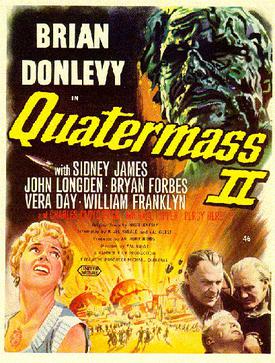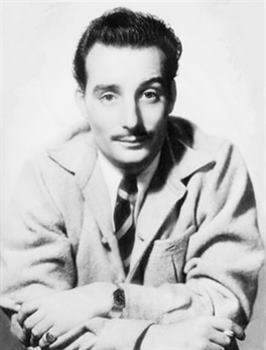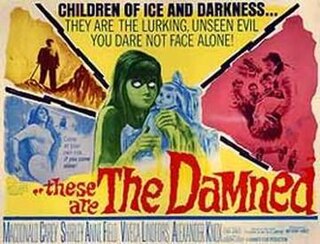
Apocalyptic and post-apocalyptic fiction is a subgenre of science fiction in which the Earth's civilization is collapsing or has collapsed. The apocalypse event may be climatic, such as runaway climate change; astronomical, such as an impact event; destructive, such as nuclear holocaust or resource depletion; medical, such as a pandemic, whether natural or human-caused; end time, such as the Last Judgment, Second Coming or Ragnarök; or any other scenario in which the outcome is apocalyptic, such as a zombie apocalypse, cybernetic revolt, technological singularity, dysgenics or alien invasion.
London has been used frequently both as a filming location and as a film setting. These have ranged from historical recreations of the Victorian London of Charles Dickens and Sherlock Holmes, to the romantic comedies of Bridget Jones's Diary and Notting Hill, by way of crime films, spy thrillers, science fiction and the "swinging London" films of the 1960s.

Quatermass 2 is a 1957 black-and-white British science fiction horror film drama from Hammer Film Productions. It was originally released in the UK as Quatermass II and was produced by Anthony Hinds, directed by Val Guest, and stars Brian Donlevy with co-stars John Longden, Sidney James, Bryan Forbes, Vera Day, and William Franklyn. Quatermass 2 is a sequel to Hammer's earlier film The Quatermass Xperiment (1955). Like its predecessor, it is based on the BBC Television serial Quatermass II written by Nigel Kneale. Brian Donlevy reprises his role as the eponymous Professor Bernard Quatermass, making him the only actor to play the character twice in a film. It is often erroneously considered as the first film sequel to use the '2' / 'II' suffix within the title, though this distinction belongs to Sanshiro Sugata Part II.

Quatermass and the Pit is a 1967 British science fiction horror film from Hammer Film Productions. It is a sequel to the earlier Hammer films The Quatermass Xperiment and Quatermass 2. Like its predecessors, it is based on a BBC Television serial, in this case Quatermass and the Pit, written by Nigel Kneale. The storyline, largely faithful to the original television production, centres on the discovery of ancient human remains buried at the site of an extension to the London Underground called Hobbs End. More shocking discoveries lead to the involvement of the space scientist Bernard Quatermass.

First Men in the Moon is a 1964 British science fiction film, produced by Charles H. Schneer, directed by Nathan Juran, and starring Edward Judd, Martha Hyer and Lionel Jeffries. The film, distributed by Columbia Pictures, is an adaptation by screenwriter Nigel Kneale of H. G. Wells' 1901 novel The First Men in the Moon.

Val Guest was an English film director and screenwriter. Beginning as a writer of comedy films, he is best known for his work for Hammer, for whom he directed 14 films, and for his science fiction films. He enjoyed a long career in the film industry from the early 1930s until the early 1980s.
Arthur Robin Christiansen was a British journalist, and editor of Lord Beaverbrook's newspaper the Daily Express from 1933 to 1957.

Derek Jameson was an English tabloid journalist and broadcaster. He began his career in the media in 1944 as a messenger at Reuters and worked his way up to become the editor of several British tabloid newspapers in the 1970s and 1980s. Later, he was a regular broadcaster on BBC Radio 2 for nearly a decade and a half, including an on-air partnership with his third wife Ellen. When his profile was at its highest, he was described by Auberon Waugh as "the second most famous man in Britain after Prince Charles."

The Abominable Snowman is a 1957 British fantasy-horror film directed by Val Guest and starring Forrest Tucker, Peter Cushing, Maureen Connell and Richard Wattis. It was written by Nigel Kneale based on his 1955 BBC television play The Creature, which also starred Cushing. It was produced by Aubrey Baring for Hammer Films.

Janet Munro was a British actress. She won a Golden Globe Award for her performance in the film Darby O'Gill and the Little People (1959) and received a BAFTA Film Award nomination for her performance in the film Life for Ruth (1962).
Edward Judd was a British actor.
Cyril Wolf Mankowitz was an English writer, playwright and screenwriter. He is particularly known for three novels— Make Me an Offer (1952), A Kid for Two Farthings (1953) and My Old Man's a Dustman—and other plays, historical studies, and the screenplays for many successful films which have received awards including the Oscar, Bafta and the Cannes Grand Prix.

Defence of the Realm is a 1986 British political thriller film directed by David Drury, starring Gabriel Byrne, Greta Scacchi, and Denholm Elliott, with Robbie Coltrane in a supporting role.

The Damned is a 1961 British science fiction horror film directed by Joseph Losey and starring Macdonald Carey, Shirley Anne Field, Viveca Lindfors and Oliver Reed. Based on H.L. Lawrence's 1960 novel The Children of Light, it was a Hammer Film production.
The 15th British Academy Film Awards, given by the British Academy of Film and Television Arts in 1962, honoured the best films of 1961.

The Daily Express Building is a Grade II* listed building located in Fleet Street in the City of London. It was designed in 1932 by Ellis and Clark to serve as the home of the Daily Express newspaper and is one of the most prominent examples of art-deco / Streamline Moderne architecture in London.

80,000 Suspects is a 1963 British drama film directed by Val Guest and starring Claire Bloom, Richard Johnson, Yolande Donlan, and Cyril Cusack. It is based on the 1957 novel Pillars of Midnight by Elleston Trevor. An outbreak of smallpox in Bath, England, leads to a race to contain the virus.
Gene Anderson was an English actress who had a career in television, film, and theatre from the early 1950s up until her death in 1965 at the age of 34. The first wife of actor Edward Judd, she is best known for her performances in the films The Long Haul (1957) and The Day the Earth Caught Fire (1961). A main cast member of the 1950s British television dramas The Crime of the Century and A Mask for Alexis, she was a frequent guest actress on British television series in the 1950s and 1960s. Also active as a stage actress, she created the role of Marie Charlet in the world premiere of Pierre La Mure's Monsieur Toulouse at the Connaught Theatre in 1957 and performed the role of Euphrenia in the first modern revival of John Ford's 1633 tragedy The Broken Heart at the Chichester Festival Theatre in 1962; a production directed by and starring Laurence Olivier. In the West End she portrayed the central role of the Nurse in the UK premiere of Edward Albee's The Death of Bessie Smith in 1961 and the role of Kate Croy in the 1963 West End adaptation of Henry James's The Wings of the Dove.














